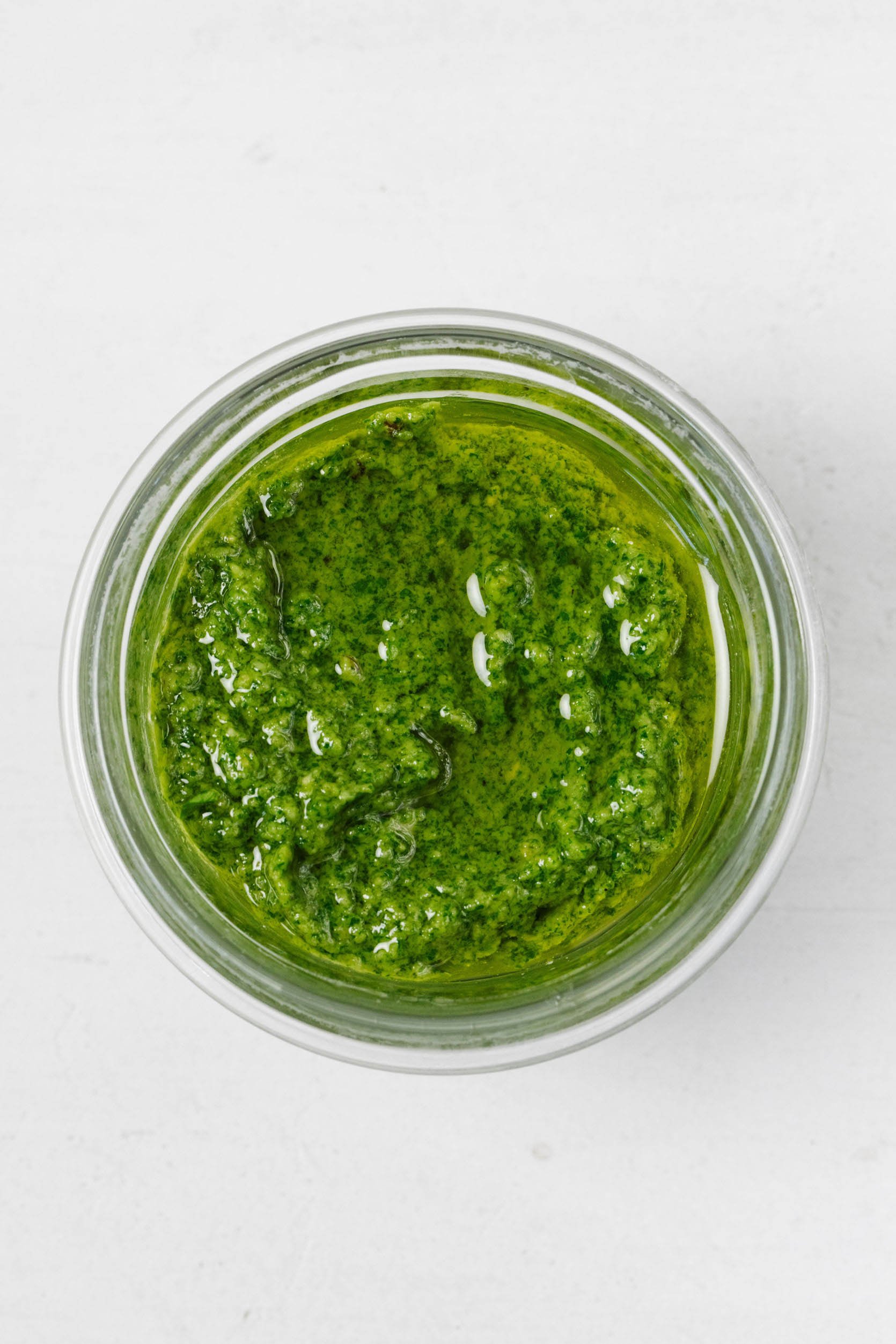This vegan pesto is a dairy-free spin on a summertime deal with: recent, flavorful, herbaceous pesto sauce. I like a thick, creamy pesto with vibrant inexperienced coloration. To attain that, I exploit cashews for texture, and I prefer to blanch my basil leaves to maintain the pesto vibrantly inexperienced. The recipe contains directions with or with out blanching.
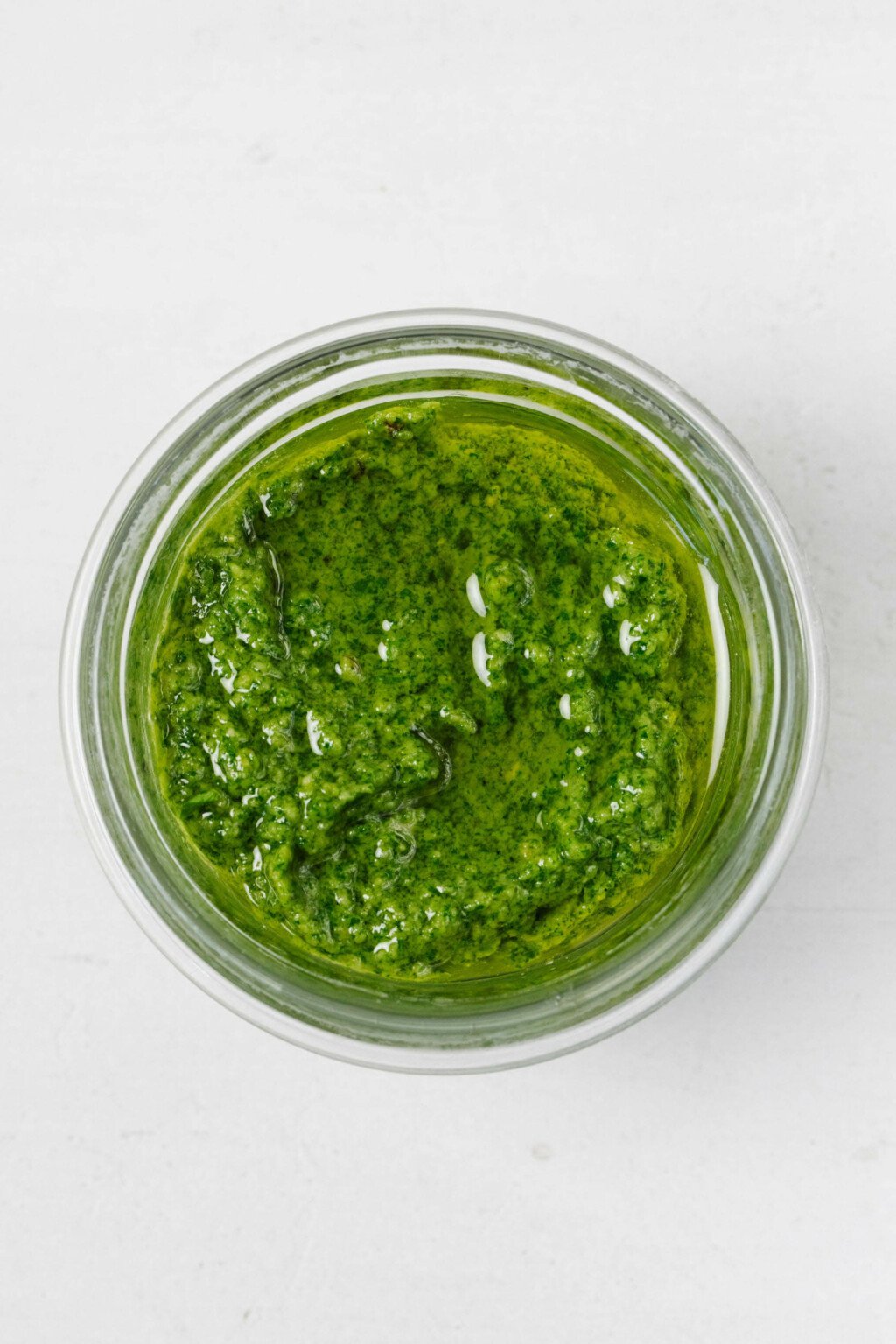
I’ve all the time thought-about September to be the final month of summer time.
The place I stay, heat climate tends to persist by the month. Some September days can compete with August of their warmth and humidity (final week was an instance of this).
From a meals standpoint, the entire summer time produce that I really like most remains to be ample in farmers markets.
There are nonetheless crates upon crates of vibrant purple tomatoes, shiny purple black eggplants, vibrant orange peaches, and sunny candy corn. I can nonetheless discover blueberries, if I poke round.
In my thoughts, then, September remains to be a month for plum galette, stewed eggplant tomato lentils, vegan BLT sandwiches, peach blackberry skillet cake, and consuming al fresco.
It’s additionally a month for pesto. Heaps and plenty of vegan pesto.
What makes pesto vegan?
Before everything, chances are you’ll be questioning what makes a pesto vegan. To the bare eye, pesto appears to be like plant-based already.
The reply is that conventional pesto recipes name for Parmesan or romano cheese. The cheese provides umami, in addition to salty taste, to the sauce.
As a way to make pesto vegan, it’s essential to substitute the parmesan for one thing plant-based that imparts a tacky taste.
Dietary yeast to the rescue.
Dietary yeast, which is usually fondly known as “nooch,” is an inactive type of yeast that’s wealthy in minerals and B-vitamins.
Dietary yeast is a typical ingredient in vegan recipes as a result of it has a naturally tacky taste. This makes it preferrred for vegan cheeses, like my go-to cashew cheese, cheese sauces, and vegan parmesan cheese.
Vegan pesto components
Except for the substitution, the components in vegan pesto are just like these in common pesto:
- Basil
- Lemon juice
- Salt
- Olive oil
There’s yet another twist in my go-to pesto recipe: cashews.
Historically, pesto options pine nuts for texture. I like pesto with pine nuts, and I’ve made it that manner loads of occasions. However truthfully, I want to make use of unroasted cashews.
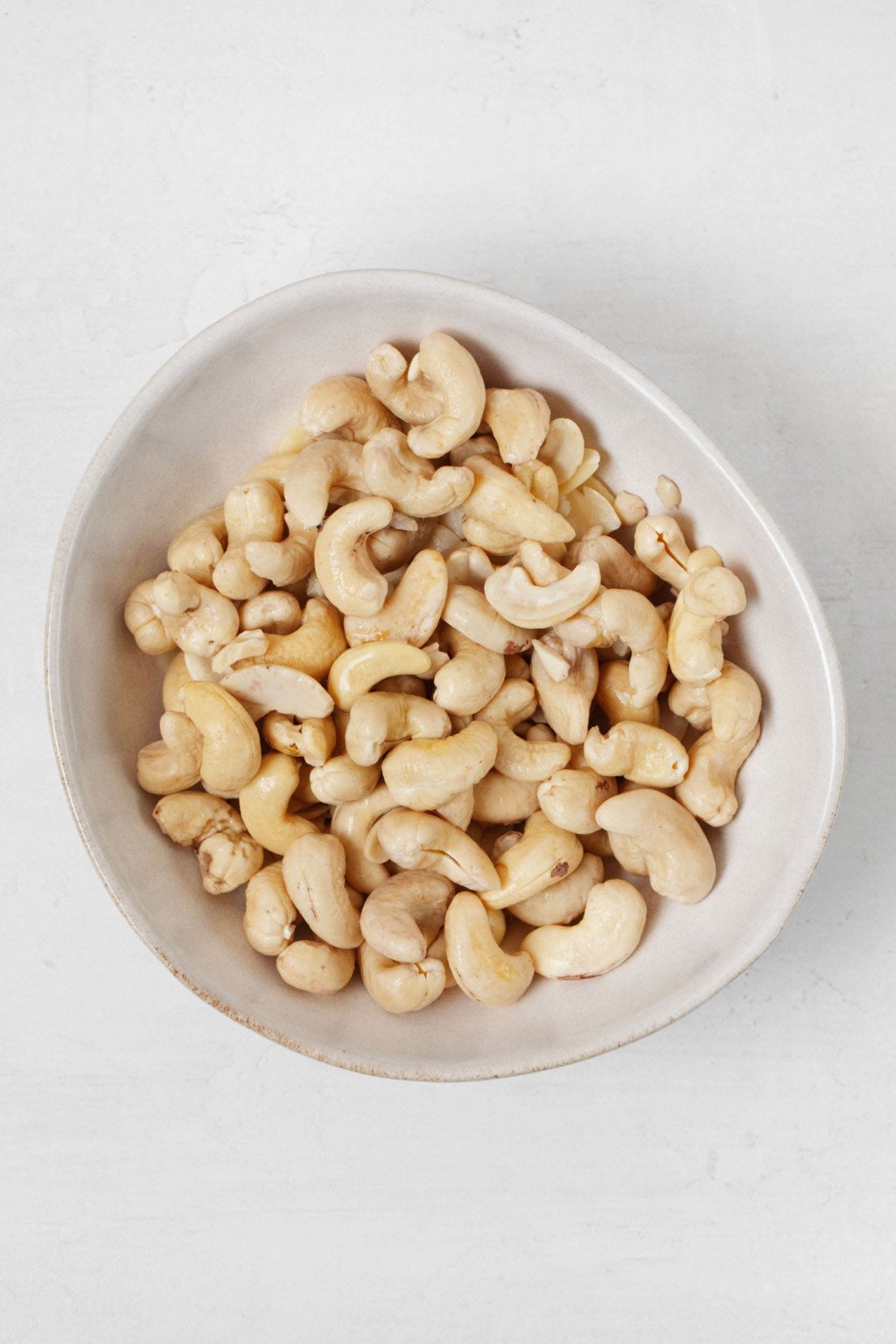
A creamier pesto
I’ve lengthy relied on cashews for creamy texture in my recipes. They’re the principle ingredient within the all-purpose cashew cream that provides a wealthy texture to a lot of my soups and pasta dishes.
Pesto isn’t a cream sauce, after all. However my private choice is for pesto that’s thick and slightly creamy, fairly than free and oily.
I believe that cashews assist to attain this texture greater than do pine nuts or walnuts.
There’s a sensible ingredient in selecting cashews, too: cashew nuts aren’t cheap, however they’re normally cheaper than pine nuts.
You probably have a cashew allergy, you merely adore pine nuts, otherwise you’re a stickler for custom, then it’s no drawback to make use of pine nuts in my pesto—I give that choice within the directions.
However should you’ve already obtained some cashews at dwelling for different dressings or home made vegan cheese, then chances are you’ll need to give them a strive in pesto as effectively.
A greener pesto, too
Have you ever heard of blanched pesto earlier than?
I hadn’t, till I got here throughout a couple of recipes (right here, right here, and right here) that made me inquisitive about it.
What’s blanched basil pesto?
Blanched basil pesto is simply what it feels like: pesto that’s made with basil that’s blanched—or flash cooked in boiling water—earlier than mixing.
Why blanch basil leaves earlier than making pesto?
The aim of blanching the basil is to create a extra vibrantly inexperienced pesto.
Pesto that’s made with blanched basil won’t solely be brighter from the beginning, however it should additionally stay vibrant.
As any pesto lover is aware of, oxidation—publicity of components to air—will typically change the colour of pesto because it’s saved. It will possibly change into darker and extra mossy wanting, or it could even seem brown. This doesn’t change the flavour of the pesto, however it may be a bummer for the eyes.
There’s a textural benefit to blanching as effectively. Pesto made with blanched basil emulsifies slightly extra simply, and due to this fact turns into a bit creamier, than un-blanched pesto.
After I first examine blanching the basil for pesto, I believed to myself that it’s the form of step {that a} chef would possibly need to take, but it surely’s too impractical for a house cook dinner.
The extra I thought of it, although, the extra I noticed how a lot I dislike it when my pesto will get muddy coloured.
Since I stay alone, I find yourself with leftovers most of the time. There’s an ick issue for me when my meals turns into discolored, even when I do know it’s not dangerous or a menace to taste.
There are methods of storing pesto that assist to stop browning. However wouldn’t it’s good to maintain that vibrant inexperienced coloration alive extra simply?
My curiosity about that query was sufficient to make me strive blanching my basil leaves. After I did, I realized two issues:
- Blanching basil leaves will not be truly as annoying because it sounds, and
- It actually does produce a brighter, greener pesto
Regardless of my preliminary skepticism, I’m now making pesto with blanched basil as a matter after all.
I really like having the pesto in my fridge for 3-4 days and persevering with to see that vivid inexperienced coloration. And, whereas the distinction is refined, I like the feel or blanched basil pesto higher, too.
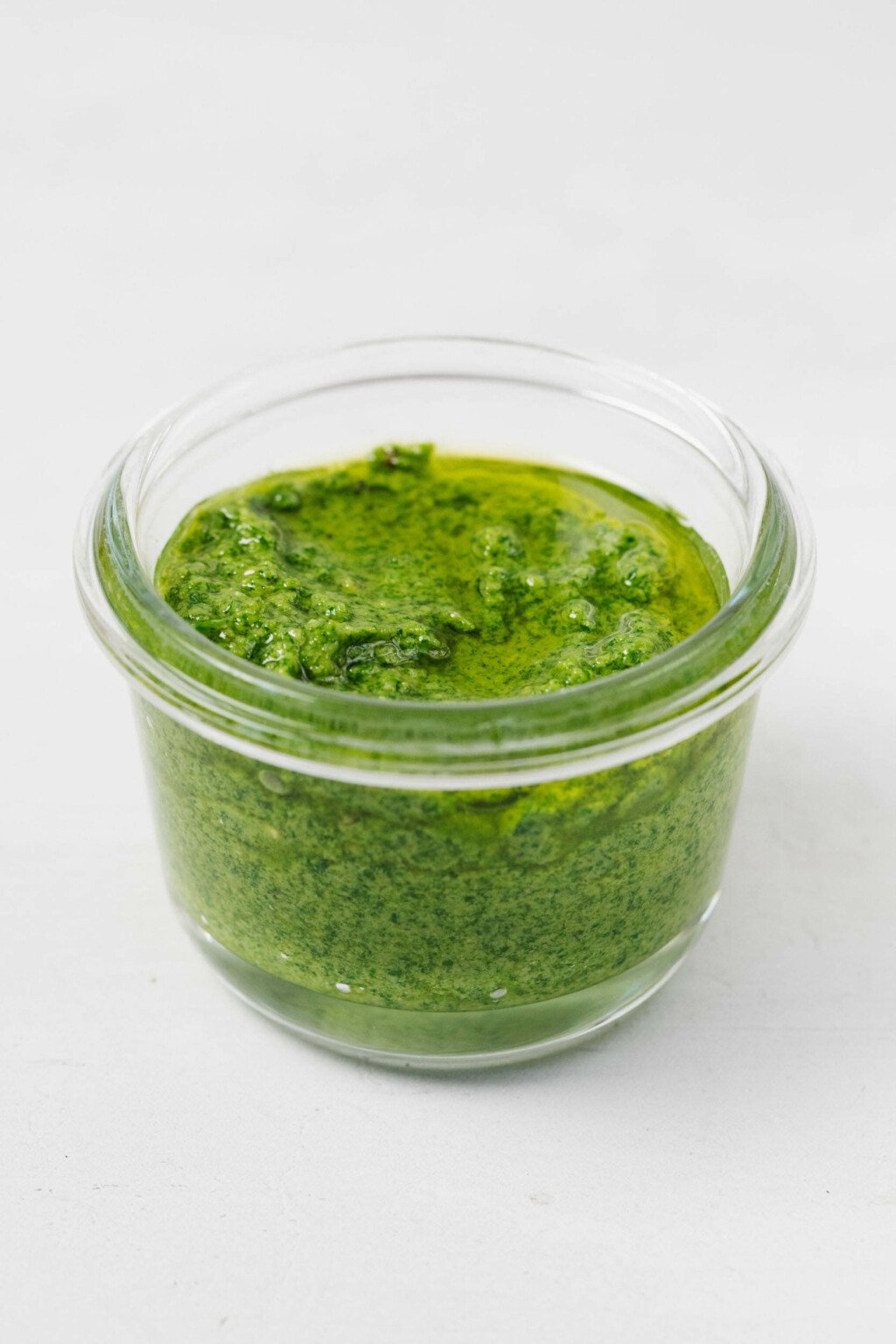
Does blanching basil change the style of pesto?
I’ve learn that blanching basil for pesto can take away considerably from the recent, zippy, lemony notes of the herb.
I don’t personally discover this impact, but it surely is sensible that flash-cooking the greens would possibly soften their taste.
TL;DR: blanching basil leaves will assist to create pesto that’s and stays greener in coloration than common pesto. The flavour is likely to be slightly softer than un-blanched pesto.
Whether or not the brightness in coloration is sufficient to justify a blanching step is completely as much as you. Under, I’ll share the method for making pesto with or with out this step.
Tips on how to make vegan pesto (blanched or un-blanched!)
Making a vegan pesto at dwelling is easy. Listed below are the steps.
Step 1: assemble your components
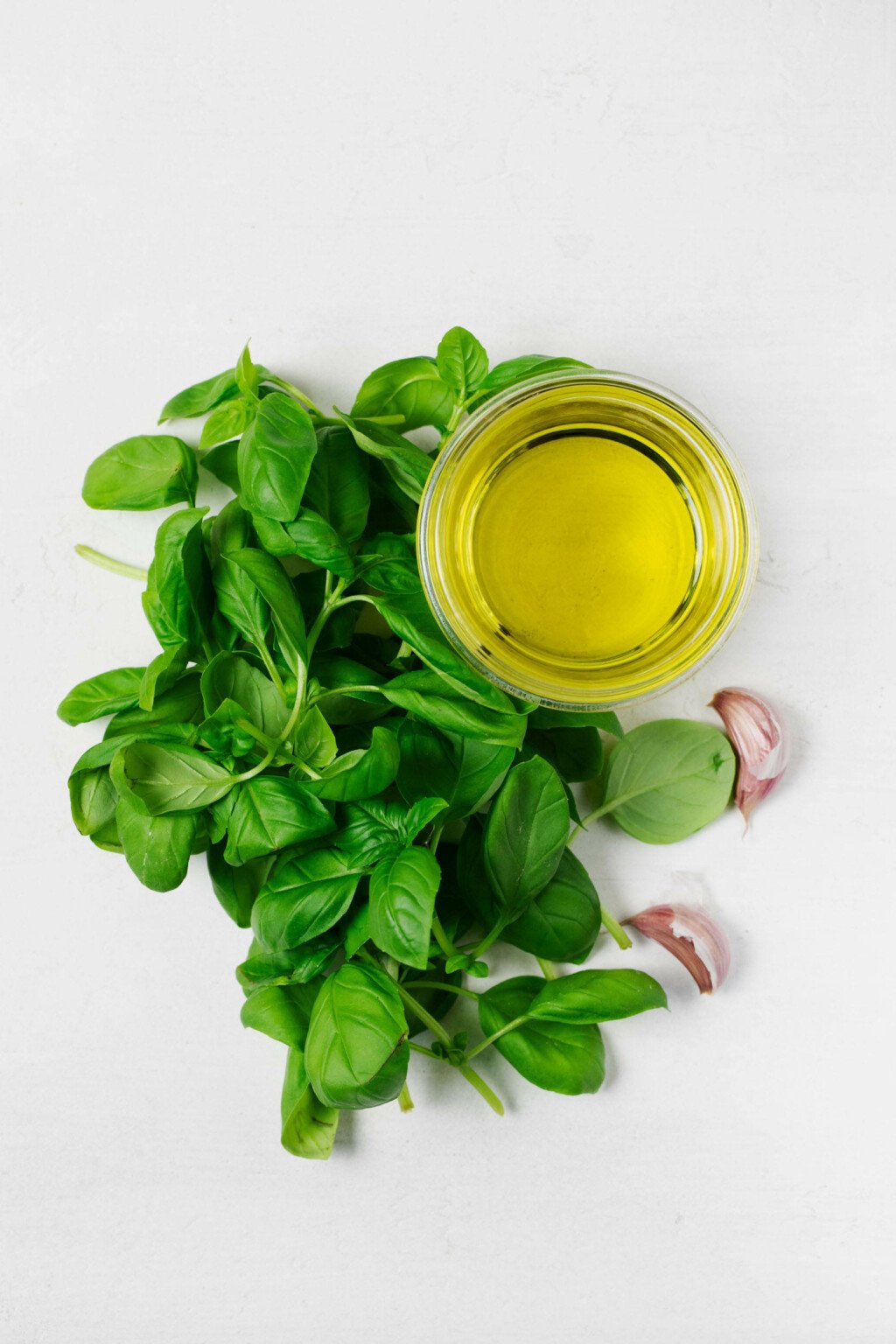
Right here’s what you’ll must make this vegan pesto recipe:
- Basil leaves
- Unroasted cashews (or unroasted pine nuts or walnuts)
- Olive oil
- Garlic
- Salt
- Dietary yeast
- Freshly squeezed lemon juice
- Freshly floor black pepper
Whereas I’m sharing a basil pesto recipe right here, it’s price saying that different greens could make fantastic pesto.
One in every of my favourite summer time dishes, butternut zucchini pesto pasta, makes use of arugula within the pesto. You can too make pesto sauce with parsley, cilantro, or kale.
Pesto rosso, which has a distinct taste profile however related texture, is made with sun-dried tomatoes. I’ve vegan sun-dried tomato pesto and pasta recipe of my very own, and it’s a wintertime favourite of mine.
Step 2 (non-compulsory): blanch your pesto leaves
When you’d prefer to strive blanching the basil, right here’s the way you do it. When you’re not on this step, skip ahead to step 3!
Deliver a medium pot of water to a boil. Whereas the water is heating up, put together an ice bathtub—equal components ice and water—in a medium sized bowl.
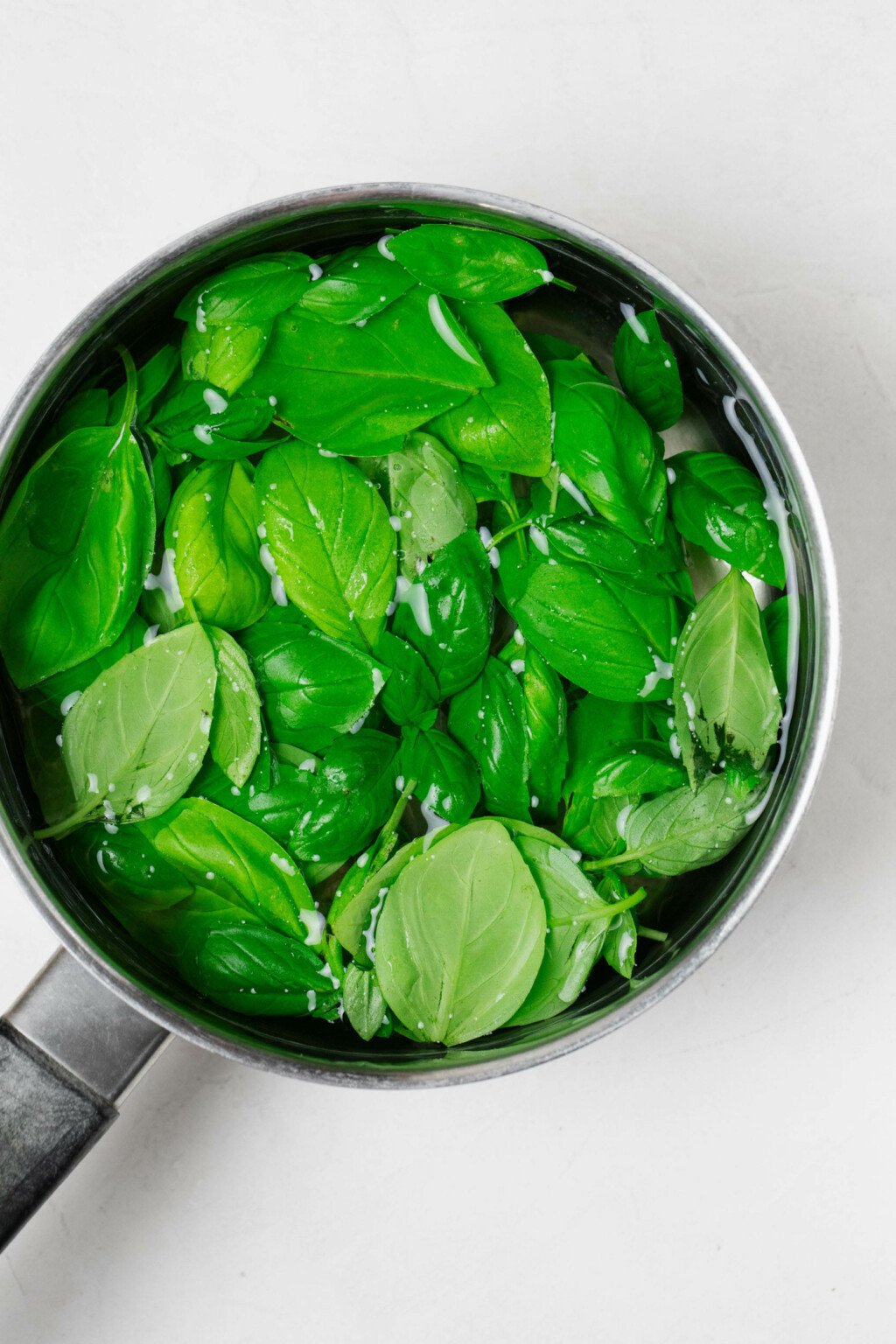
Add the basil to the recent water. Blanch for 15 seconds, then use a slotted spoon to switch the basil to the ice bathtub. By the point you switch all of it, a lot of the basil may have blanched for about 30 seconds.
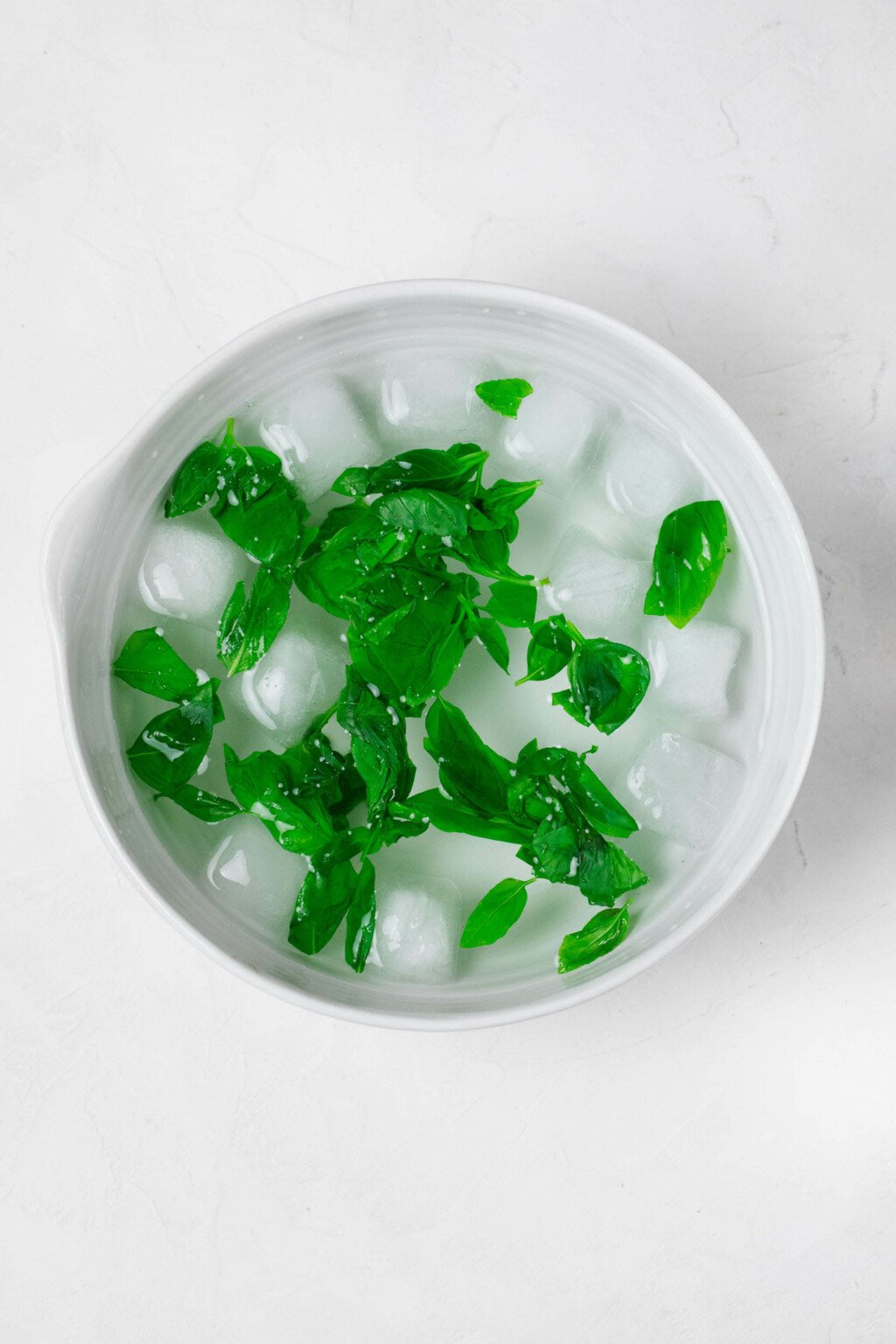
After you switch the basil leaves to the ice bathtub, permit them to take a seat for 3-5 minutes. The thought right here is to chill the basil down in a short time, halting cooking fully.
Use the slotted spoon to switch the basil leaves to some tea towels or paper towels. Give them a very good squeeze—sufficient to wring the entire moisture from them.
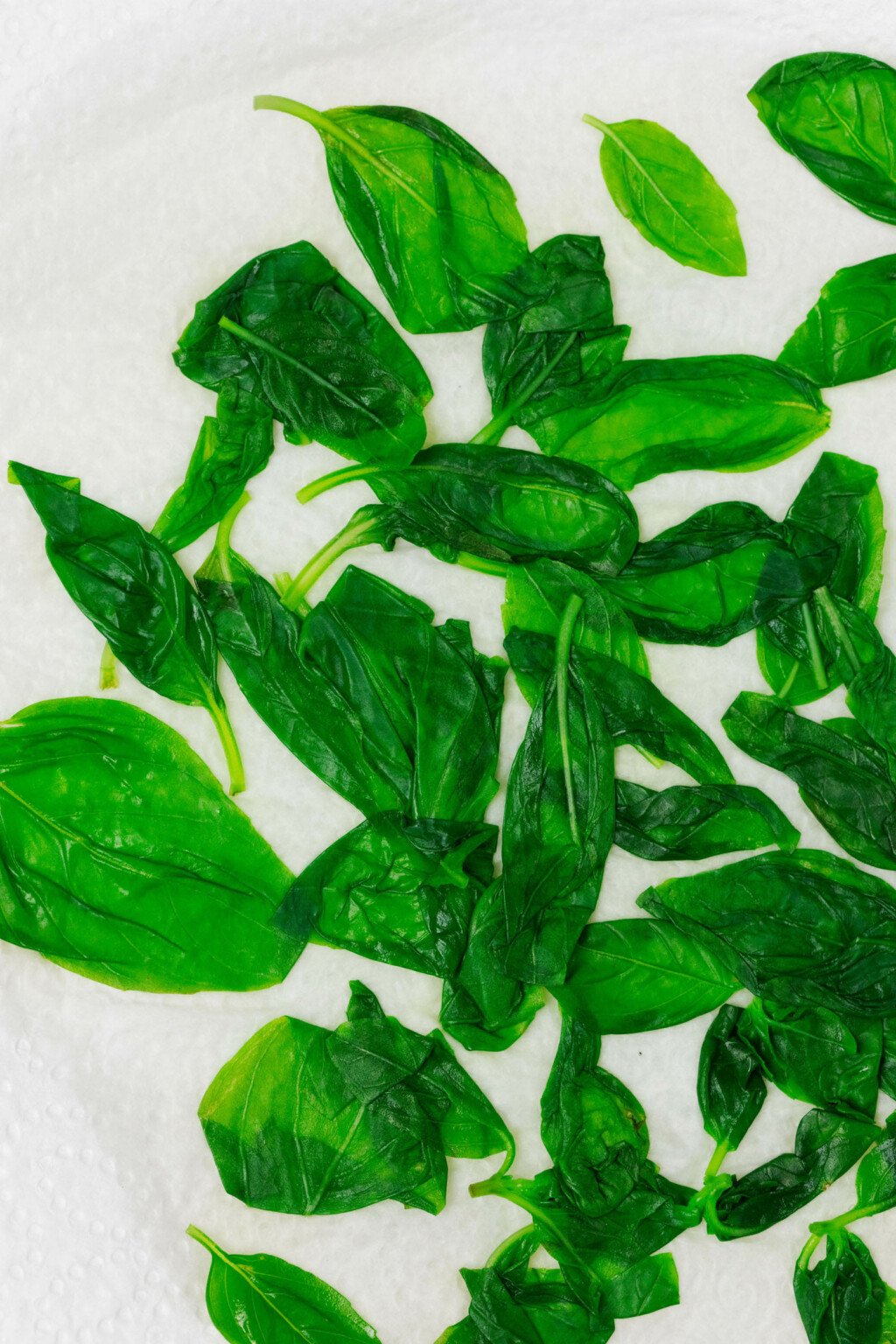
At this level, the basil leaves are able to change into a part of your vegan pesto.
Step 3: Course of
Start by including the cashews, garlic and salt to a meals processor fitted with the S blade. Add your blanched or uncooked basil leaves (uncooked leaves are pictured beneath) to the processor.
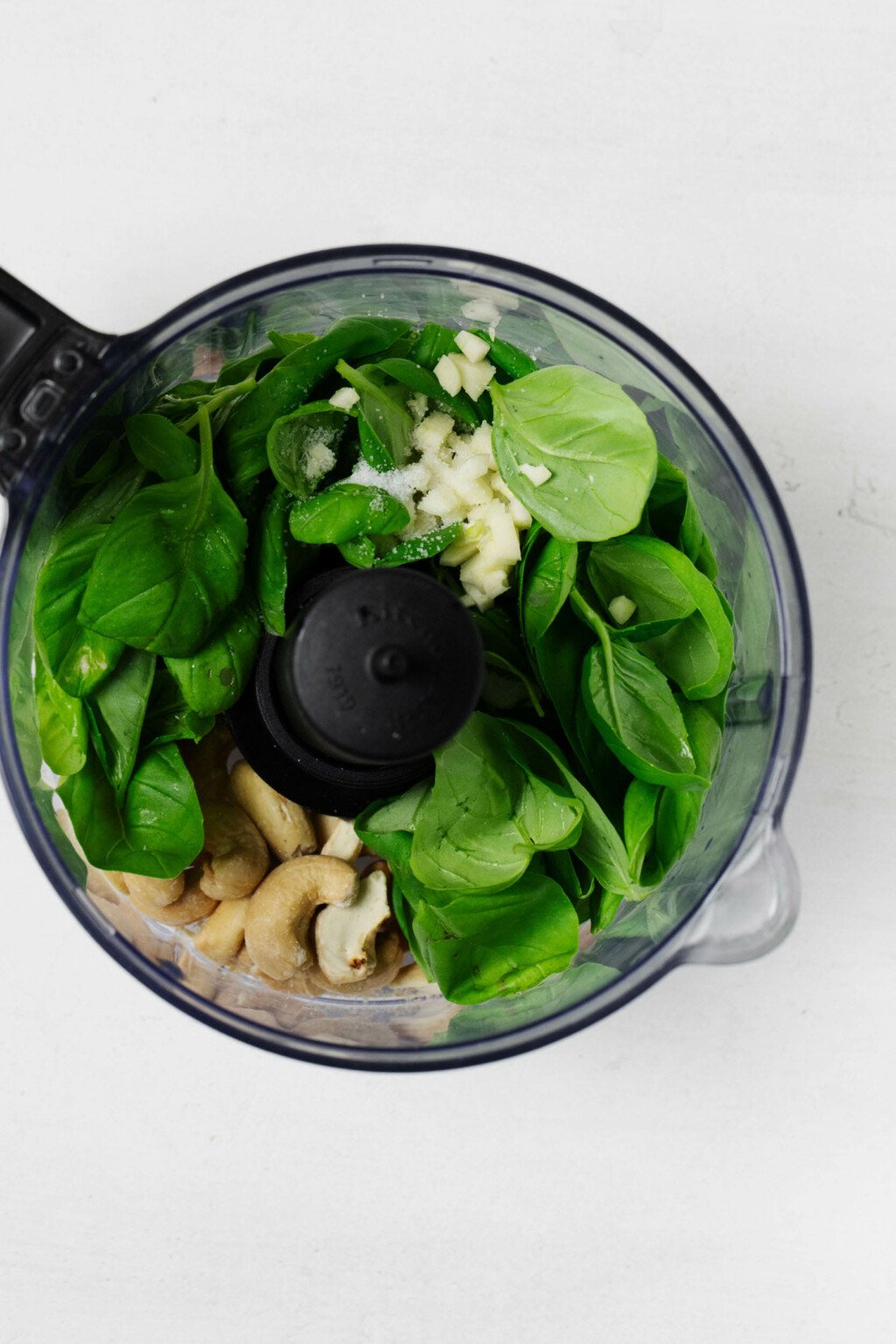
Pulse these components till they’re coarsely floor.
Step 4: Emulsify
Subsequent, you’ll add the olive oil to your pesto. The purpose is so as to add it in a skinny stream, whereas the processor is working: this emulsifies the pesto, making a wealthy and built-in texture.
You possibly can both add the oil by hand in a skinny stream, or—relying in your meals processor—you may place the plunger into the meals processor spout.
This plunger has a tiny gap in it. The aim of that gap is to permit liquids (normally oil) to drip into the processor in a skinny, regular stream. That’s the impact that you really want.
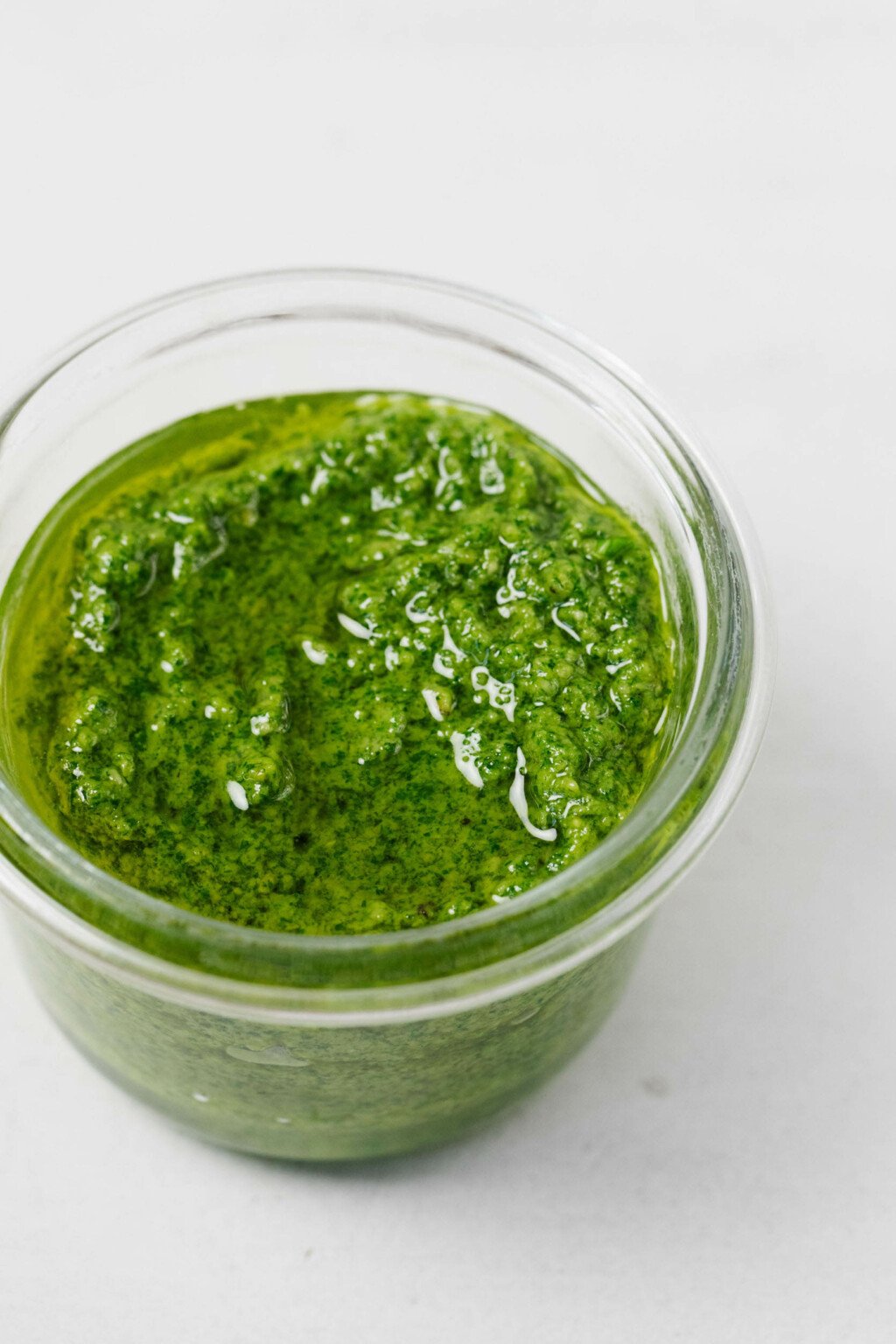
As soon as the oil has been added to the meals processor, you’ll have pesto with a creamy and thick texture.
At this level, you need to add your dietary yeast, freshly squeezed lemon juice, and freshly floor black pepper to style to the pesto.
When you love warmth, you should use crushed purple pepper flakes as a substitute of black pepper for a spicy pesto.
Step 5: Retailer
Retailer the pesto in an hermetic container within the fridge for as much as 5 days.
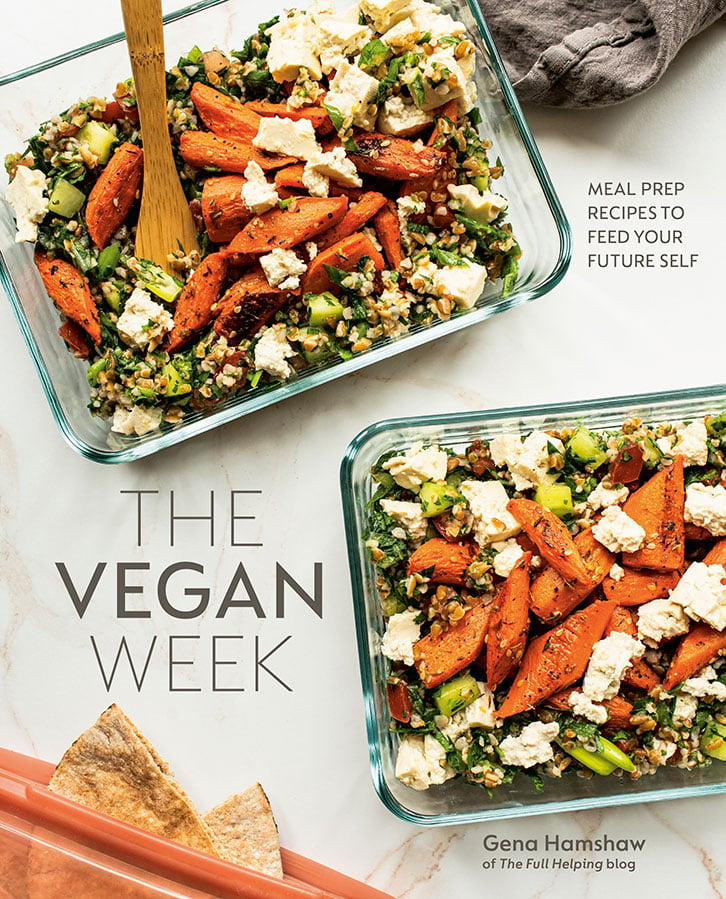
The Vegan Week
Embrace the enjoyment of consuming home made meals daily with the hearty and healthful recipes in The Vegan Week.
Whether or not you’ve three, two, and even only one hour of time to spare, The Vegan Week will present you how one can batch cook dinner assorted, colourful, and comforting dishes over the weekend.
Can pesto be frozen?
Pesto can completely be frozen.
When you’d like to do that in small quantities, you may truly use an ice dice tray for pre-portioning.
As a substitute, I like to make use of 4-ounce mason jars, which I exploit for a lot of different issues: leftovers, freezing tahini dressing, portioning my beloved silken tofu chocolate pudding, and so forth.
Saved this manner, pesto can keep within the freezer for as much as 6 weeks.
What recipes ought to I make with my vegan pesto?
When you put together your pesto, there can be so many pasta dishes you should use it in.
Pesto can also be an ideal, all-purpose summer time condiment. I really like spreading it onto any sandwich, particularly if thick slices of ripe tomato are concerned.
When you’d like extra particular concepts, listed below are a couple of of my favorites:
And right here’s the recipe.
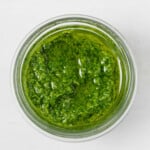
Yields: 1 cup
- 2 cups tightly packed basil leaves (45 g)
- 1/2 cup unroasted cashews (70 g)
- 2 cloves garlic, roughly chopped
- 1/2 teaspoon nice salt (extra to style)
- 6 tablespoons olive oil (90ml, plus extra oil as wanted)
- 3 tablespoons dietary yeast
- 1 tablespoon freshly squeezed lemon juice
- Freshly floor black pepper to style
Directions for blanching basil (non-compulsory)
-
Deliver a medium pot of water to a boil over excessive warmth. Whereas the water is heating up, put together an ice bathtub in a medium sized bowl.
-
Add the basil to the recent water. Blanch for 15 seconds, then use a slotted spoon to switch the basil to the ice bathtub. By the point you switch all of it, a lot of the basil may have blanched for about 30 seconds.
-
Enable the basil to stay within the ice bathtub for 3-5 minutes. Place a couple of tea towels or paper towels onto your work floor and use the slotted spoon to switch the basil over to the towels. Use the towels to press the basil firmly, so that you simply take away the entire extra ice water.
Course of the pesto
-
Add the cashews, garlic and salt to a meals processor fitted with the S blade. Add the blanched or uncooked basil leaves to the processor. Pulse the components till they’re coarsely floor.
-
Run the meals processor. Add your olive oil to the processor in a skinny stream — utilizing the plunger attachment, with its small backside opening, makes this simple in case your machine has one — in order that the oil is included into the pesto slowly and steadily. Cease the processor and scrape down the edges, then course of for an additional few moments.
-
Add the dietary yeast, a couple of turns of freshly floor black pepper, and lemon juice to the pesto. Course of the pesto for yet another minute; it is going to be on the thicker aspect.
-
Style the pesto and modify the lemon juice, salt, and pepper to style. If the pesto is just too thick in your liking, add a tablespoon or two of extra olive oil and pulse to mix.
Scripting this put up—which felt good, by the best way—has most undoubtedly made me hungry for pasta! I count on that’s what’ll be for supper tonight.
Perhaps you’ll be impressed alongside related traces. I hope you take pleasure in this pesto recipe as a lot as I do.
xo

